| dc.contributor.advisor | Lord, Wayne | |
| dc.contributor.author | O'Bannon, Elizabeth | |
| dc.date.accessioned | 2020-05-26T20:40:54Z | |
| dc.date.available | 2020-05-26T20:40:54Z | |
| dc.date.issued | 2013 | |
| dc.identifier.other | (AlmaMMSId)9980680385202196 | |
| dc.identifier.uri | https://hdl.handle.net/11244/324792 | |
| dc.description.abstract | The development of taxonomic keys for carrion-associating blow flies (Diptera: Calliphoridae) has greatly enhanced the field of forensic entomology by facilitating identification of species often associated with crime scenes. Keys for morphological identification of blow flies have been developed and refined by Whitworth (2006) and Marshall, et al. (2011). Research involving habitat preferences, ovipositional behavior, developmental rates, and succession to decaying matter has proved vital for the estimation of a post mortem interval (PMI) for crime scene investigators. Within the state of Oklahoma, there is suspected habitat overlap and migration of Calliphoridae species, stemming from varying environmental conditions and resource availability. This study assessed the relationship between morphological and genetic identification of three blowfly species (Lucilia cuprina, Lucilia sericata, and Lucilia mexicana) sampled from eight different locations within Oklahoma and one island location off of the coast of New Hampshire. A 308 basepair amplicon within the cytochrome oxidase I gene of mitochondrial DNA was obtained for twenty-four specimens. An additional genomic location was targeted to support the robustness of laboratory analyses. A 330 basepair amplicon within the 28S large subunit of ribosomal DNA was obtained for thirty-five specimens. Molecular phylogenetic results were compared to morphological identifications in order to ascertain the reliability of the respective laboratory techniques. Morphological and genetic identification techniques confirmed the previously undocumented presence of L. mexicana within Oklahoma. COI data was unreliable for distinguishing between morphologically similar Lucilia species; however 28S phylogenetic assessments were successful in defining most Calliphoridae species. Results serve as a template for future ecological and forensic research. | |
| dc.rights | All rights reserved by the author, who has granted UCO Chambers Library the non-exclusive right to share this material in its online repositories. Contact UCO Chambers Library's Digital Initiatives Working Group at diwg@uco.edu for the permission policy on the use, reproduction or distribution of this material. | |
| dc.subject.lcsh | Forensic entomology | |
| dc.subject.lcsh | Blowflies | |
| dc.title | Identification of morphologically similar species of necrophagous flies (diptera: calliphoridae) in Oklahoma : reliability and application of techniques in a forensic setting. | |
| dc.type | Academic theses | |
| dc.contributor.committeeMember | Creecy, James | |
| dc.contributor.committeeMember | Hellack, Jenna | |
| dc.thesis.degree | M.S., Forensic Science | |
| dc.subject.keywords | Entomology | |
| dc.subject.keywords | Molecular biology | |
| dc.identifier.oclc | (OCoLC)ocn884518993 | |
| uco.group | UCO - Graduate Works and Theses::UCO - Theses | |
| thesis.degree.grantor | Jackson College of Graduate Studies | |
